The following is an in-depth examination of the Michelle Pfeiffer Catwoman from Batman Returns, exploring how the filmmakers adapted her narrative and characterisation from the comics. This will primarily focus on comics published before the movie came out. Some of this material has already been mentioned in other threads, but a lot of it is new. This is pretty extensive, so I've broken it up into several subsections to make it easier to read. These include:
- Origins
- Alter Ego
- Narrative
- Appearance & Character Traits
- Martial Arts, Stealth & Thievery
- Nine Lives
- Psychology
Hopefully this will illustrate how the movie version of Catwoman relates to the source material. It should also offer some insight into the evolution of the Pre-Crisis Catwoman for those not familiar with that era of the comics.
ORIGINS
Quote
"...showing the creation of these characters, that takes up time [...] That's the great thing about comics. I mean one comic will focus on the creation of Catwoman, or the creation of Penguin. So [with] these movies you are throwing a lot into the mix, into one thing."Tim Burton's commentary for Batman Returns
When Catwoman first appeared in 'The Cat' (Batman #1, Spring 1940) she had no origin story or alter ego. She was simply a femme fatale in a red dress, known only as the Cat. The name Selina Kyle wasn't introduced until 'The Secret Life of the Catwoman!' (Batman #62, December 1950). In this story it was revealed that Catwoman was previously an air stewardess who fell out of a crashing airplane and banged her head. The fall left her with amnesia and sent her into a fugue state, wherein she became Catwoman.
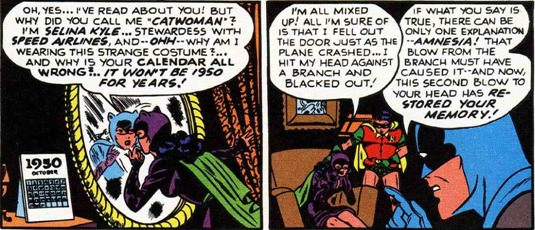
This origin was later retconned during the Bronze Age story 'The Autobiography of Bruce Wayne' (Brave and the Bold #197, April 1983). Here Selina reveals that the story about her being an air stewardess with amnesia was all a lie. Her true back story is that she was once the trophy wife of a cruel but wealthy businessman who used to beat her. Eventually Selina left her husband and avenged herself against him by breaking into his office and stealing the jewels from his safe. She then discovered she had an appetite for crime and continued her life as Catwoman.
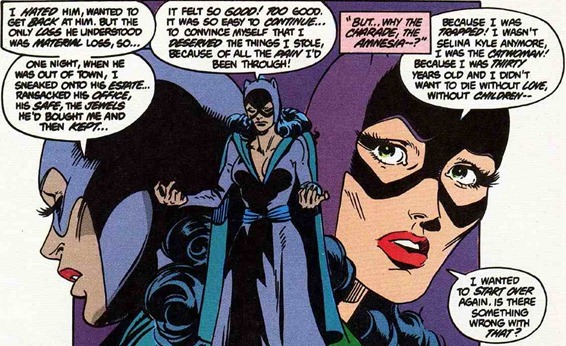
It's worth noting that this second origin story only applies to the Earth-Two version of Catwoman. The amnesia origin story from Batman #62 still applies to the Earth-One Catwoman of the Silver and Bronze Age comics.
Selina also claims to have amnesia in Batman Returns when she shows up during Bruce and Max's meeting. But as in the Earth-Two comics, this is merely a lie to conceal what really happened. In truth she was pushed out of a window by her boss, Max Shreck. From this we can already see how elements of the two Pre-Crisis origins have been implemented: firstly, that Selina entered her Catwoman mental state after suffering a near death experience that resulted in head trauma (falling out of a crashing plane/falling from a window in Max's office); secondly, that her transformation into Catwoman was an act of emancipation so she could avenge herself against a domineering male figure who'd previously abused her (her husband/her boss).
This pattern is also evident in the 1989 Catwoman Volume 1 miniseries by Mindy Newell, J. J. Birch and Michael Bair. Later collected in trade paperback form as Catwoman: Her Sister's Keeper, this was Catwoman's canonical origin story at the time Batman Returns was made. It's also one of the primary comic book influences, along with Frank Miller's The Dark Knight Returns (1986), from which the movie drew inspiration. It was specially reissued in 1992 to coincide with the film's release.
Catwoman: Her Sister's Keeper begins with Selina being raped, brutally beaten and left for dead in an alleyway by her pimp, Stan. The scene in the movie where the cats inspect Selina as she lies motionless in the alleyway, teetering on the brink of death and bathed in cold moonlight, was adapted directly from this book. In both the movie and comic, this scene is the turning point that triggers Selina's journey to becoming Catwoman.
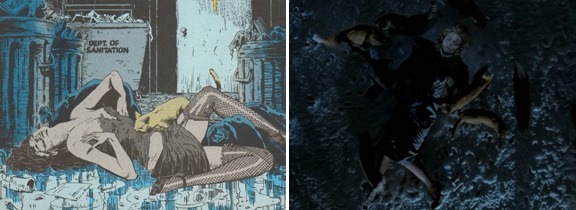
Of course Selina survives in both the comic and the movie, and subsequently embarks on a quest for revenge against the man who almost killed her. This new variation on Selina's origins has clear parallels with the Pre-Crisis versions: Selina becomes Catwoman after surviving a near-death experience, and initially does so in order to get revenge on the man responsible. But now Selina is depicted as a prostitute, a working girl, and the domineering male figure in her life is her boss instead of her husband. This more contemporary approach to her origins is reflected in the movie.
ALTER EGO
Quote
''When you look at the evolution of Catwoman in the old comic books from the 30's, she was obviously representative of women from that era. And when you look at her in the 50's, she's more voluptuous and kitten-like while in the 70's she became much more muscular and streamlined. The Catwoman in this movie is definitely a reflection of what's happening today.''
It's interesting to note that before the air stewardess alter ego was introduced in 1950, Catwoman had already had several other secret identities. In 'The Princess of Plunder' (Batman #10, April 1942) she operated under the guise of a rich socialite named Marguerite Tone. In 'Your Face is Your Fortune' (Batman #15, February 1943) Catwoman's alter ego was that of a salon worker named Elva Barr. Elva was a working girl who lived alone in a small apartment with her cat and was constantly talking to herself. Her characterisation is remarkably similar to the movie version portrayed by Pfeiffer.

The Elva Barr alter ego was arguably the first to portray Catwoman as a fully rounded character and was significant for several reasons. For one thing it was the first time Catwoman was shown to have an ordinary life away from her criminal activities, with her own modest apartment and a legitimate daytime job. It was also the first comic to show Bruce Wayne romancing Catwoman's real self as opposed to simply flirting with her costumed persona.
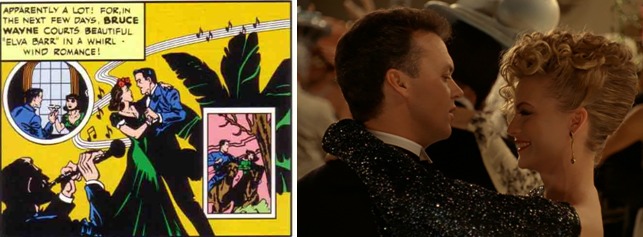
Catwoman's subsequent alter egos were not so fleshed out. In 'The Duped Domestics' (Batman #22, April 1944) she masqueraded as a beautiful woman named Belinda in order to woo Bruce Wayne's butler Alfred as part of a criminal scheme. In 'Fashions in Crime!' (Batman #47, June 1948), Catwoman posed as Madame Moderne, the publisher of a women's fashion magazine. Her disguise in this story – comprised of a blonde wig, business suit and glasses – was similar to Selina's appearance in the early scenes in Batman Returns.
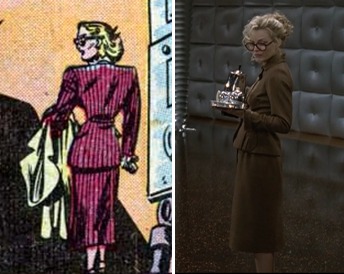
Selina Kyle reformed during the latter part of the Golden Age and began a law-abiding life working in a pet shop. During this period she was depicted as an honest and hard working woman, constantly struggling against the traumatic memories of her criminal past.
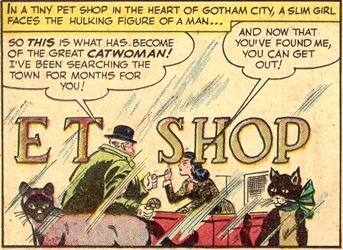
In contrast to the urbane socialite Selina of modern comics, the Golden Age version was mostly depicted as a down-to-earth middleclass woman, often at odds with her duel identity. This characterisation has clear parallels with the version we see in the movie.
NARRATIVE
As mentioned earlier, Catwoman's origin/revenge narrative in this film is loosely adapted from Catwoman: Her Sister's Keeper. Her first costumed exploit in the film sees her rescuing a woman from a rapist in an alleyway. This mirrors her first costumed battle in the book where she fights Stan in an alleyway and scratches his face with her claws.
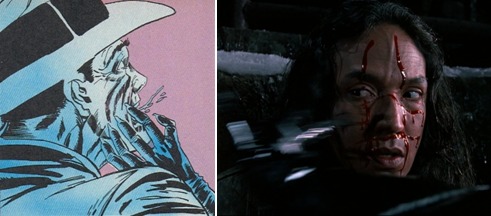
This scene could also be a reference to 'It's a Man's World' (Batman #460, March 1991), the last two-part Catwoman story to be published before Batman Returns was released. Her first appearance in this comic sees her rescuing a woman from a gang of rapists in an alleyway, slashing the faces of the attackers and afterwards chiding the woman for carelessly placing herself in harm's way.
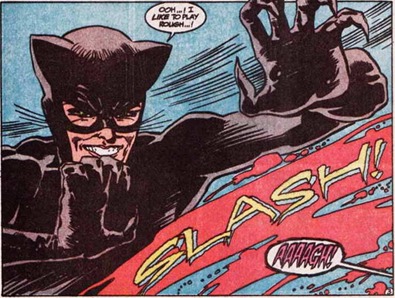
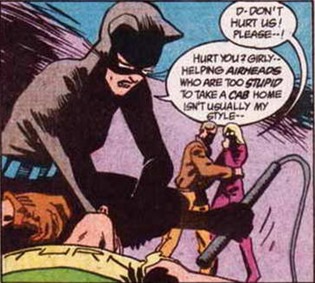
Catwoman's primary objective in both Catwoman: Her Sister's Keeper and Batman Returns is to get revenge on her boss after he almost kills her. To this end, the movie Catwoman enters into a short-lived alliance with the Penguin. Catwoman and Penguin shared an equally brief alliance in 'The Catwoman's Black Magic!' (Superman's Girlfriend Lois Lane #70, November 1966). As in the movie, their union was characterised by betrayal and unrequited affection.
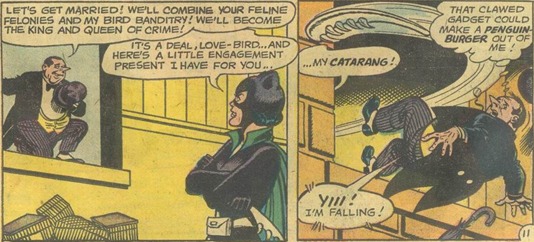
Inevitably the movie sees Catwoman coming into conflict with Batman. Their first rooftop confrontation in Batman Returns is another scene influenced by Catwoman: Her Sister's Keeper. In both the comic and the movie, Catwoman uses her sexual presence to toy with Batman before suddenly attacking him without warning.
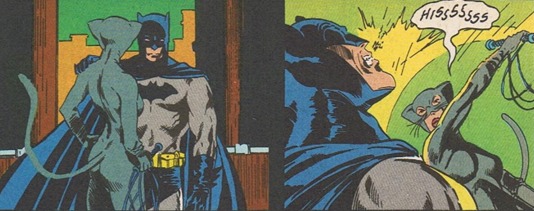
She slashes him with her claws, leaving him with scars to remember her by.

In both Catwoman: Her Sister's Keeper and Batman Returns, Catwoman eventually catches up to her former boss and would-be killer and avenges herself by taking his life. Catwoman's moral code is a complex one and has varied greatly from era to era. The original Earth-Two Catwoman of the Golden Age comics never killed anyone. She would sometimes try to kill Batman, but always relented at the last second. By contrast, the Silver Age Catwoman was far more ruthless and had no compunction about eliminating her enemies (below left).
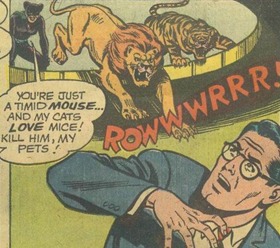
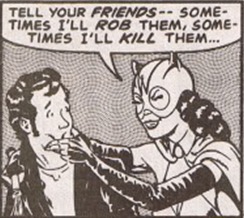
The Catwoman in the 1989 syndicated newspaper strip was equally coldblooded and killed several drug dealers (above right).
Even the Post-Crisis Catwoman has killed on occasion, perhaps most memorably when she executed Black Mask in 'Backward Masking Conclusion' (Catwoman #52, April 2006).
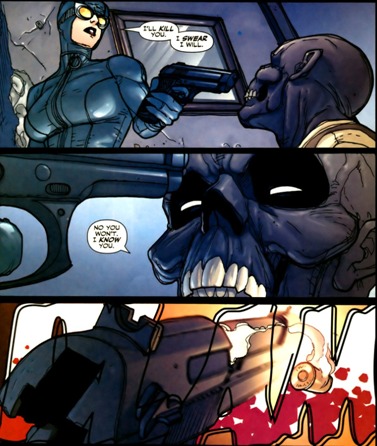
The scene where Selina kills Max in the movie has obvious parallels with Stan's death scene from Catwoman: Her Sister's Keeper. It also echoes a later scene from that book, where Catwoman goes after a corrupt police officer who assaulted her friend Holly.
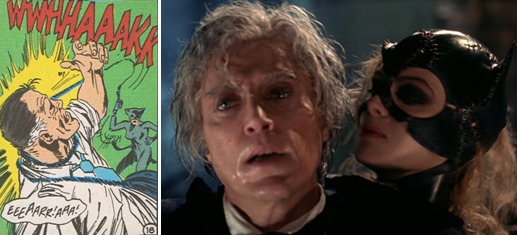
Batman shows up and tries to dissuade Selina from killing him.

The content of their ensuing discussion reveals that Catwoman, while cynical of the legal system, is not without conscience or moral values. The same could be said of the Catwoman portrayed by Pfeiffer. It is also during this scene in the movie that Batman unmasks himself in front of Catwoman, finally revealing his true identity to her. The Earth-Two Batman did the same thing in the classic Bronze Age story 'The Autobiography of Bruce Wayne' (Brave and the Bold #197, April 1983). This was a major event in the life of the Earth-Two Batman, and one that led to him and Selina getting married and having a daughter together.
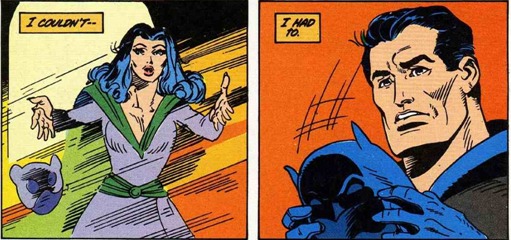
Catwoman's fate is far less certain at the end of the movie. But the short-lived Birds of Prey (2002) television series offers a possible future scenario where a Catwoman resembling the Pfeiffer version has a child with Batman. And as in the Earth-Two comics, this child grows up to be the superhero known as the Huntress. While this series is not officially part of the Burtonverse canon, it can still be regarded as a possible continuation of the events depicted in Batman Returns.
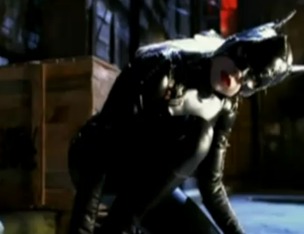
APPEARANCE AND CHARACTER TRAITS
While Selina Kyle is nowadays portrayed as a brunette, her hair colour was not always consistent in the Pre-Crisis comics. And during the Golden Age in particular she was sometimes drawn as having fair hair like the movie version. Even when she was drawn with dark hair, Selina would often wear blonde wigs in order to disguise herself.
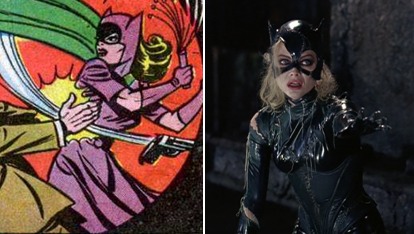
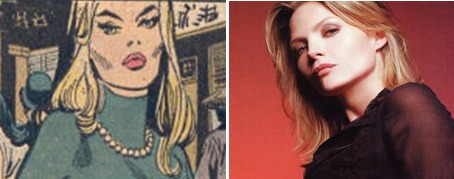
Her costume in the movie is similar to the one she was wearing in the comics at the time the film was in production. It consists of a skin-tight suit, gloves, high heel boots and a cowl. According to Batman: Year One and Catwoman: Her Sister's Keeper, Selina had seen Batman in action and was inspired by him to make her own costume. The Pfeiffer Selina also saw Batman in action and made her own costume following his example.
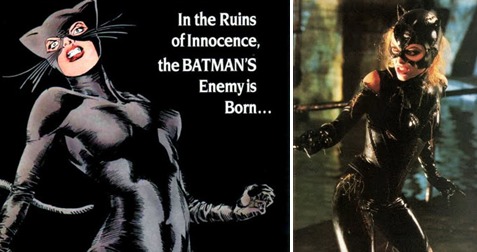
Catwoman's earliest masks in the comics resembled real cat heads. The familiar cat-eared cowl made its debut in 'Nine Lives Has the Catwoman' (Batman #35, June 1946).

Here's a behind-the-scenes photograph showing Bob Kane painting an unnamed model, taken circa 1940. Note the cowl is the same shape as the one worn by Pfeiffer.
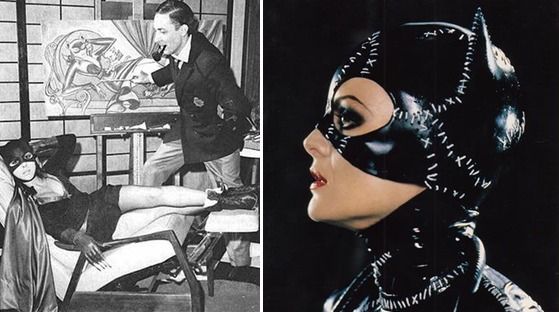
In the comics Catwoman has two signature weapons which she has consistently used since the 1940s: her claws and her whip. She first wielded a whip in the Golden Age story 'A Christmas Tale' (Batman #39, February 1947).
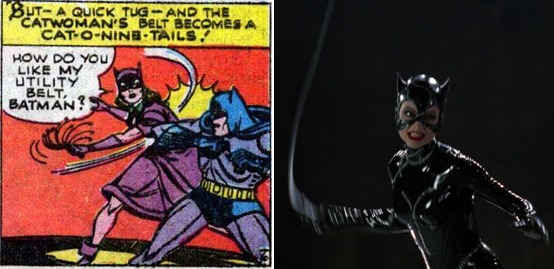
Batman #39 was also the source of the movie scene where Batman and Catwoman share a romantic moment beneath the mistletoe.
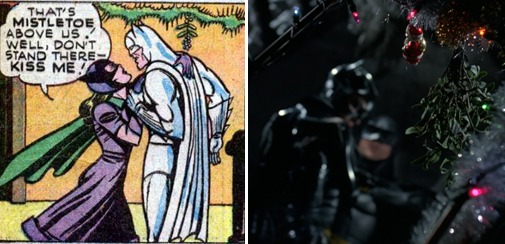
At the time Batman Returns was in production, the Catwoman in the comics sported a tail as part of her costume. While the movie costume lacks this aspect, there are several scenes where Catwoman coils her whip around her body so that part of it hangs down like a tail.
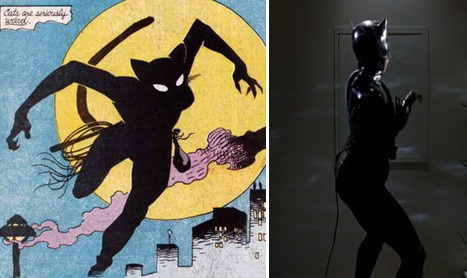
In the very early comics Catwoman scratched at her enemies using her real fingernails (below left). From Batman #10 onwards she wore artificial claws over her gloves (below right).
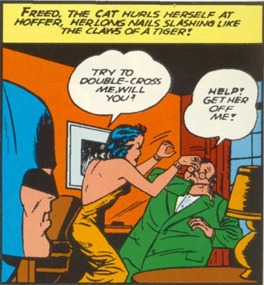
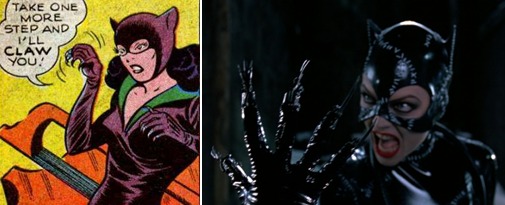
Even in comics where she didn't wear gloves, she still had razor-tipped fingernails.
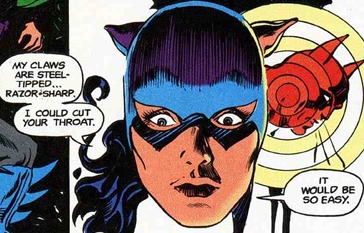
In the movie Selina's apartment is flooded with stray cats. The Selina in the comics also collects stray cats in her apartment, as illustrated by this example from Catwoman: Her Sister's Keeper.
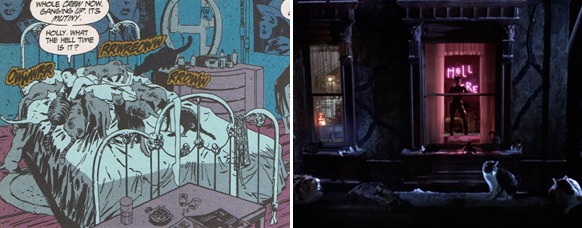
The image of Catwoman reclining on a couch or bed with her black cat beside her while she plots her latest scheme is typical of the Golden Age comics. Almost every Catwoman story from that era features such a panel.
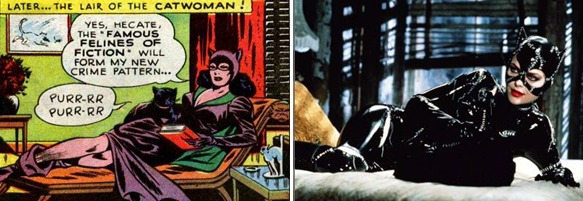
Another noteworthy aspect of Catwoman's behaviour is her use of feline gestures and sounds. In the movie she says "meow" before blowing up Shreck's department store. The Pre-Crisis Catwoman would use "meow" as a code word to signal her henchmen. She also hisses like a cat during her second fight with Batman. Again, this is something the Catwoman in the comics does when angered.
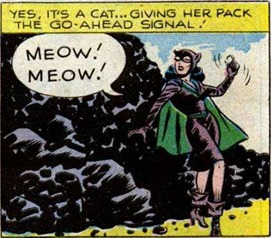
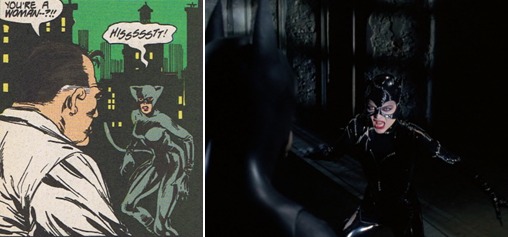
The Catwoman in the comics also displays a propensity for wisecracks, constantly taunting Batman and her other adversaries with jibes. Her playfulness is an integral part of her appeal and one characteristic that has remained consistent throughout pretty much every interpretation. The movie Catwoman is no exception.
MARTIAL ARTS, STEALTH AND THIEVERY
In the Pre-Crisis comics Catwoman's methods varied from story to story. Sometimes she was depicted as a femme fatale, other times as a morally ambiguous ally for Batman. Sometimes she went after money and jewels, other times she simply pulled off novelty crimes themed around cats. Sometimes she was depicted as a gang leader who sent minions to do her work, other times she was depicted as a hands-on criminal who operated alone.
In the Post-Crisis comics Catwoman works solo and is invariably depicted as either a thief or a vigilante. Regardless of her objective, she is depicted as a skilled gymnast, lock breaker, martial artist, and an expert with the whip.
While cat burglary doesn't play an important part in the objectives of the Pfeiffer Catwoman, she does nevertheless display thievish skills throughout the film. Early in the movie Selina is able to access Shreck's protected files without his permission. Later she manages to break into Shreck's department store without triggering the alarm, seeing off a pair of inept security guards in a manner typical of her comic counterpart.
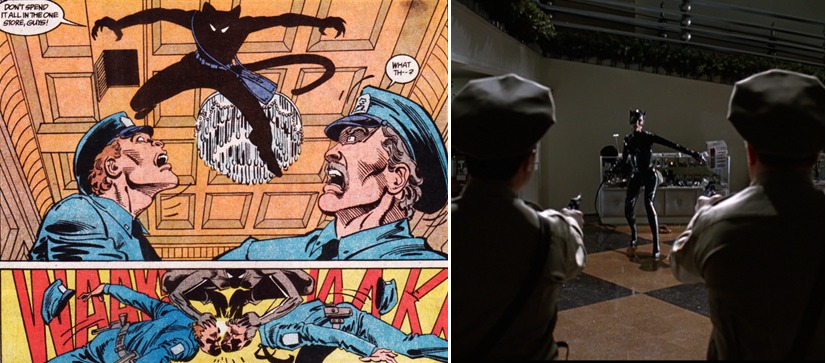
We also see her using her claws to scale the side of a building, just like the comic Catwoman has done on countless occasions.
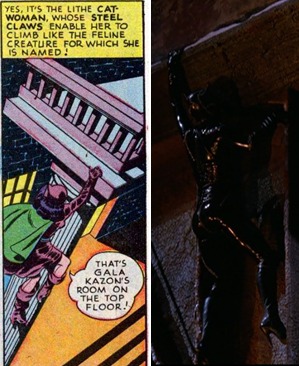
She displays further stealth and agility when Batman comes to rescue the Ice Princess. Prior to their fight, Catwoman is able to cling to the ceiling without Batman seeing her, then swing down and take him by surprise. Catwoman in both the movie and comics is shown to be an extremely skilled martial artist, capable of standing toe to toe against Batman himself.

Catwoman is also shown to possess tremendous feline grace and agility, cart-wheeling and back-flipping with apparent ease. Again, this is consistent with the abilities of her comic book counterpart.
As to how Catwoman acquired her skills, the answer to that question can be found in scenes excised from the original script. No explanation was ever given for how Catwoman learned martial arts/gymnastics in the Pre-Crisis comics; her abilities simply emerged by themselves following her mental transformation. According to Catwoman: Her Sister's Keeper, the Post-Crisis Selina was trained in self-defence by Ted Grant (aka Wildcat) after a police officer recommended her to his rape prevention class following her near-death assault at the hands of Stan.
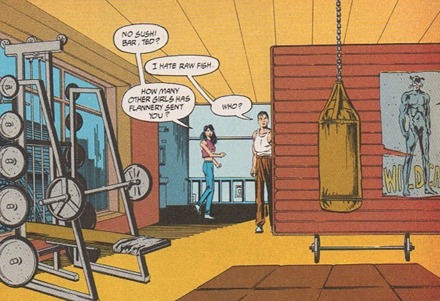
The August 1st 1991 draft of the Batman Returns script mentions that the movie version of Selina had also attended rape prevention classes.
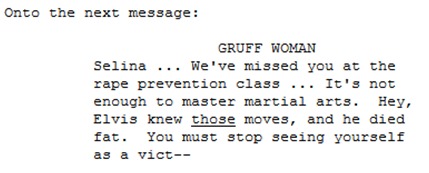 |
In this draft, her martial arts instructor leaves a message on her answering machine asking why she has stopped attending classes. It's unknown whether this dialogue was recorded or not.
Daniel Waters' script also hints at other sporting endeavours from Selina's past. He describes photographs in her apartment that show her rock climbing, horse riding and jumping on a trampoline. Her physical skills are further hinted at when her boyfriend breaks up with her on her answering machine. Selina's response to this is "Guess I should've let him win that last racquetball game," suggesting she has no difficulty dominating men in sporting events and has to wilfully downplay her physical prowess in order to avoid humiliating them.
NINE LIVES
Catwoman's nine lives were a recurring trope during the Pre-Crisis era of Batman comics.
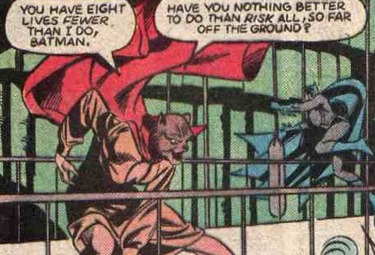
Writer Bob Kane once cited the nine lives myth as a primary reason for choosing the cat motif:
Quote
Why a cat? "Well a cat has nine lives," Kane emphasizes. "So I figured that whenever she was caught, or wounded, she would survive and live again for another go-round with Batman."(Page 16 of Batman Returns: The Official Movie Book by Michael Singer)
Early Catwoman stories often ended with her plunging into the sea, or disappearing after a vehicular wreck, only to return unscathed a few issues later. The idea of her having nine lives was frequently referenced in an offhand manner.
On other occasions the nine lives motif played a more central role in Catwoman's capers. An early example of this would be the Golden Age story 'Nine Lives Has the Catwoman' (Batman #35, June 1946), in which Catwoman survives a sequence of life-threatening encounters by virtue of trickery and simple good luck. Each time this happens, she counts down how many lives she has remaining.
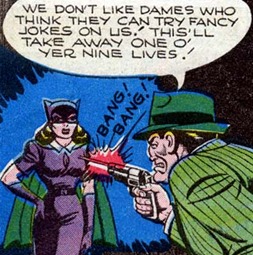
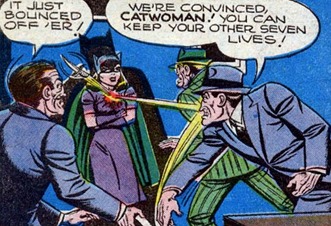
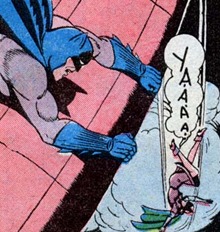
She loses her first life after being shot...her second after having a knife thrown at her...and her third after falling from a dirigible during a fight with Batman.
She then pulls off a series of crimes and loses a further four lives in the process: one from a gunshot, one from a burning building, one from a car crash, and one more from another gunshot. The story ends with Catwoman driving a tractor off a cliff and Batman reflecting that she still has one life left.
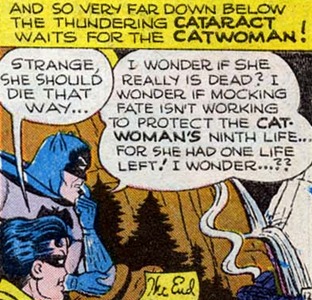
Another memorable comic to explore the nine lives theme was the Silver Age story ‘The Case of the Purr-loined Pearl!’ (Batman #210, 1969). Here Catwoman recruits eight recently paroled female felons, dresses them in Catwoman costumes and trains them to move and fight like she does; thus creating eight additional lives to aid her in her crimes.
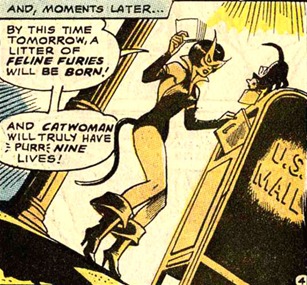
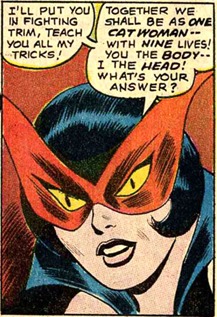
Perhaps the most extensive exploration of the nine lives motif was the Cat-Man story arc that began in 'The Challenge of the Cat-Man!' (Detective Comics #311, January 1963) and continued throughout the Silver and Bronze Ages. While previous stories based around this theme had offered rational explanations for the nine lives, this story arc presents them as purely supernatural. Cat-Man's costume had been made from a material taken from a Pacific island on which the natives worshiped cats. Consequently it bestowed its wearer with extra lives that allowed them to cheat death nine times.
Cat-Man loses his first life in Detective Comics #311 when he plunges over a cataract. He loses his second life at the end of ‘The Cat-Man Strikes Back’ (Detective Comics #318, August 1963) when he crashes a motorboat into a marker buoy and blows himself up. He squanders an additional three lives in ‘The Strange Lives of the Cat-Man’ (Detective Comics #325, March 1964): once by jumping off a cliff, a second time by electrocution, and a third by walking through fire. Kathy Kane then assumes the mantle of Catwoman, wearing a costume made from the same material as Cat-Man's and using up three of his remaining lives.
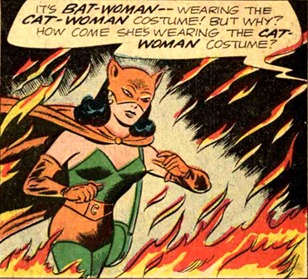
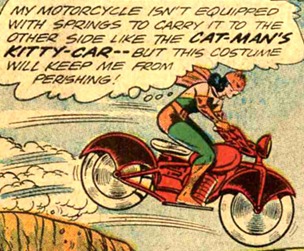
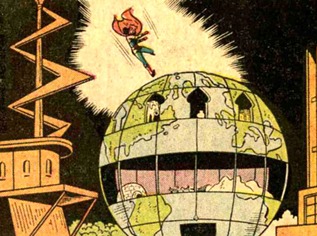
She uses up one life walking through fire...another when she rides a motorcycle off a ravine...and one more when she jumps off the roof of a skyscraper.
By the end of this story Cat-Man has only one life left. Sixteen years later, Cat-Man's remaining life would be stolen by the Selina Kyle Catwoman in ‘The Cat Who Would Be King!' (Batman #324, June 1980). Selina had contracted a deadly and incurable illness in ‘Chaos – Coming and Going!’ (Batman #322, April 1980). By tearing off part of Cat-Man's costume in Batman #324 she is able to steal his remaining life and make a miraculous recovery. Neither Bruce Wayne nor her doctors are able to account for this in rational terms.
This led to an ongoing feud between Cat-Man and Catwoman during the Bronze Age. Cat-Man would return in 'Nine Lives Has the Cat' (Detective Comics #509, December 1981) and try to take Selina's life as revenge for the one she stole from him.
The Pfeiffer Catwoman goes through a similar sequence of potentially lethal encounters in the movie, each time counting down how many lives she has remaining. The film is deliberately vague about whether she really does have nine lives or whether she simply thinks she does. The movie doesn't show her injuries magically healing the way Highlander (1986) or The Crow (1994) do with their supernatural protagonists. And on the DVD commentary Tim Burton states that Catwoman's nine live are not supernatural:
Quote
"...you see the creation with the cats coming around her. It's not supernatural. But we feed into the sort of mythology a little bit; of cats and nine lives and all that sort of thing [...] It's not supernatural, but you don't really know."Tim Burton's commentary for Batman Returns
If we examine each of her 'deaths' from a non-supernatural perspective, we can see how Selina might have survived by simple good fortune.
Her first life is lost when Shreck pushes her out of a window. According to the original script, Max's office is five storeys up. In the movie it appears to be more like seven or eight storeys.
On the way down she hits four awnings that slow her rate of descent, then lands in a soft bed of snow. The fall is sufficient to knock her unconscious, but she doesn't die. The original script even had the Batmobile driving past the alleyway and Selina weakly calling out to Batman for help. The Joker survived a similar fall in 'The Joker's Advertising Campaign' (Batman #11, June 1942) and walked away without injury.
Selina's next life is lost when Batman punches her off a ledge. There's no mystery about this one as we clearly see her land softly in a truck full of kitty litter. The exact same thing happened in 'The Mad Hatter Goes Straight!' (Batman #297, March 1978) when Batman punched a criminal off a cliff, only for him to land in a truck full of sand and be carried safely away.
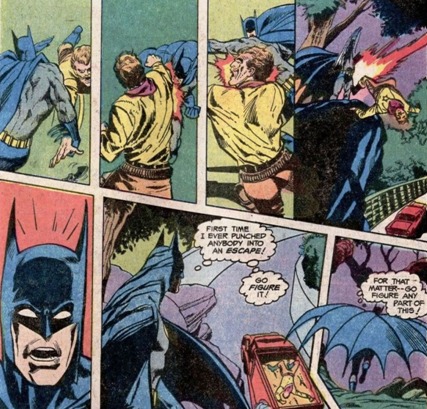
Catwoman loses her third life in the movie when the Penguin tries to kill her by latching his umbrella-copter to her neck. The use of slow motion in this scene makes it difficult to gauge exactly how far she falls after freeing herself from the umbrella. But evidently the greenhouse and shrubberies she lands on break her fall.
Catwoman loses four more lives towards the end of the film when she is shot repeatedly by Shreck. This scene is easily explained by looking at the bullet wounds visible on her body: one is located on her left shoulder, another on her right upper arm and a third grazed her left thigh. None of these hit vital organs and the fourth bullet presumably missed her altogether.
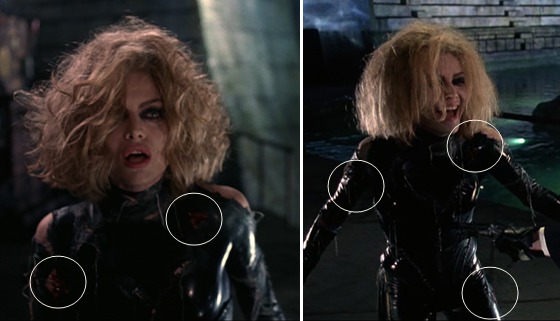
It's also worth noting that the Catwoman in the comics has been shot on numerous occasions and always lived to fight another day.
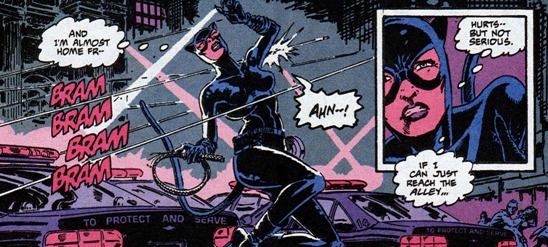
We must also take into account that the gun Shreck used had been immersed in water for an unknown number of hours without being subsequently cleaned. The water and the chemicals it contained may have adversely affected the weapon and the ammunition within.
Catwoman loses her eighth life when she electrocutes Shreck in the Penguin's hideout. She grabs an overhead cable and places a taser in Shreck's mouth, then the generator blows up and she apparently disappears. Selina's insulated costume would have protected her against electrocution provided she didn't actually place the taser in her own mouth. And Batman is unable to locate her body in the resultant wreckage, suggesting that she snuck away before the explosion occurred.
Although Burton has stated that Catwoman in this movie is not supernatural, he nevertheless gives his audience enough ambiguity to interpret the film for themselves. Ultimately it's down to the individual viewer to decide whether Catwoman's nine lives are the product of simple good luck or some magical agency. Either way, both interpretations have precedents in the comics. And by having her attribute her survival instincts to her feline totem, Burton gives Selina a compelling psychological reason to adopt the mantle of the cat.
PSYCHOLOGY
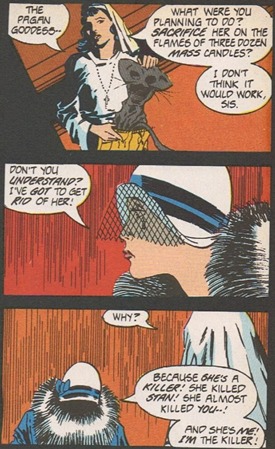 |
While the modern day Catwoman is ostensibly sane, the Pre-Crisis version suffered from a number of mental issues including identity confusion, amnesia and hints of multiple personality disorder.
The Catwoman in the movie displays symptoms of similar problems. At one point she tells Bruce she doesn't know who she is anymore, and in another scene she's shown talking to her reflection in a shop window as though it were a separate person.
This is similar to Selina's psychological deterioration in Catwoman: Her Sister's Keeper, and in particular one scene where she discusses the Catwoman persona with her sister. During this scene Selina refers to Catwoman in the third person as though she were a separate person over whose actions she has no control.
Selina comes to terms with her multifaceted personality by the end of the book. Her movie counterpart is not so fortunate. But Catwoman's mental health issues go back further than Catwoman: Her Sister's Keeper. As I mentioned earlier, the Pre-Crisis Selina became Catwoman after sustaining a serious head injury. This injury and the effect it had on her memory and identity would create many problems for Selina in later years.
After she regained her memory in Batman #62 Selina reformed and started working in a pet shop. In 'Empress of the Underworld' (Batman #65, June 1951) the criminal Whale Morton managed to convince Selina that she had subconsciously resumed her criminal activities as Catwoman. Selina was so unsure of her own mental state that she fell for Morton's trick, convincing herself that she must have committed the crimes without consciously realising it, when in reality she was completely innocent.
The memory problems of the Earth-Two Selina proved to be her eventual downfall, as depicted in 'Huntress: From Each Ending... A Beginning!' (DC Super-Stars #17, December 1977). In this story Selina Wayne, now married to Bruce, was blackmailed by a criminal into believing she had killed someone. Again, Selina was innocent. But she couldn't trust her own memories over the falsified evidence her blackmailer presented. This set in motion a chain of events that would lead to the death of the Earth-Two Catwoman and Bruce Wayne's retirement as Batman.
Throughout the Bronze Age Catwoman was portrayed as having a changeable temperament and violently unstable personality. Her capriciousness was memorably demonstrated in 'Never Scratch a Cat' (Batman #355, January 1983), in which she rams Bruce Wayne's car into a river because she is jealous of his relationship with Vicki Vale. Realising Bruce and Vicki will drown, she suddenly has a change of heart and dives into the river to try and rescue him. At the end of the story Batman tries to help Catwoman achieve catharsis by allowing her to beat him up. It gets to the point where she is about to slit his throat with her claws, when she suddenly has another change of heart and breaks down crying.
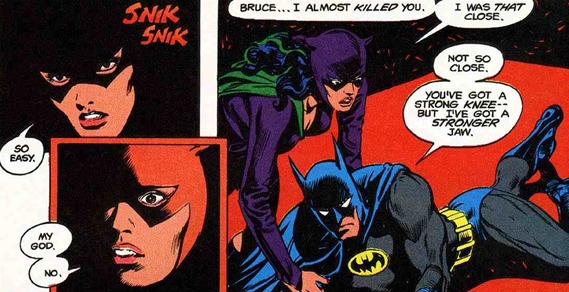
Batman offered moral and emotional support to Selina throughout the Bronze Age, but even he had difficulty understanding what was going on in her head.
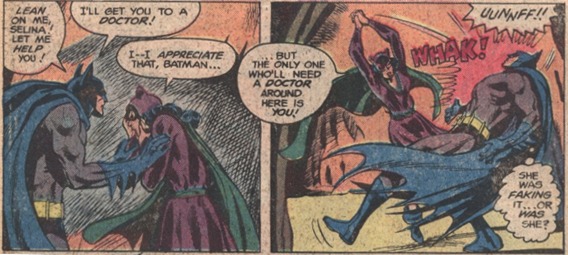
Catwoman's unpredictability and emotional turmoil in these comics made her less of a flat out villain and more of a tragic heroine, constantly treading the fine line between good and evil. The movie version is equally complex and can also be seen as a tragic heroine. Batman's approach to her in the film – compassionately trying to save her soul and steer her away from a life of crime – is reflective of Batman's attitude towards Selina in the Bronze Age comics. He represents a calming influence and her only chance for a happy life.
CONCLUSION
Putting it simply, you could say the Michelle Pfeiffer Catwoman is essentially a combination of the Golden Age and Pre-Zero Hour versions from the comics. Her origin/revenge narrative is adapted from Catwoman: Her Sister's Keeper, but her personality displays many traits of the Pre-Crisis Catwoman.
Hopefully the examples presented here have shown that while Burton may have taken liberties with his depiction of the Penguin, his portrayal of Catwoman is very much substantiated by the source material.
comments powered by Disqus












by Silver Nemesis
by Silver Nemesis
by Silver Nemesis
by The Joker
by The Joker
by The Joker
by The Joker
by The Dark Knight
by Silver Nemesis
by The Dark Knight